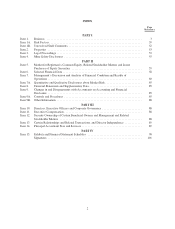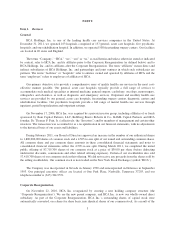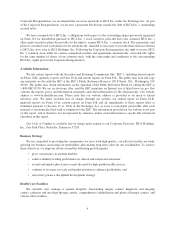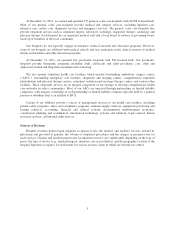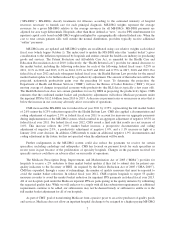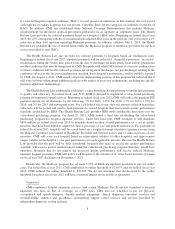HCA Holdings 2011 Annual Report Download - page 15
Download and view the complete annual report
Please find page 15 of the 2011 HCA Holdings annual report below. You can navigate through the pages in the report by either clicking on the pages listed below, or by using the keyword search tool below to find specific information within the annual report.Managed Medicare
Managed Medicare plans relate to situations where a private company contracts with CMS to provide
members with Medicare Part A, Part B and Part D benefits. Managed Medicare plans can be structured as HMOs,
PPOs or private fee-for-service plans. The Medicare program allows beneficiaries to choose enrollment in certain
managed Medicare plans. In 2003, MMA increased reimbursement to managed Medicare plans and expanded
Medicare beneficiaries’ health care options. Since 2003, the number of beneficiaries choosing to receive their
Medicare benefits through such plans has increased. However, the Medicare Improvements for Patients and
Providers Act of 2008 imposed new restrictions and implemented focused cuts to certain managed Medicare
plans. In addition, the Health Reform Law reduces, over a three year period starting in 2012, premium payments
to managed Medicare plans such that CMS’ managed care per capita premium payments are, on average, equal to
traditional Medicare. The Health Reform Law also implements fee payment adjustments based on service
benchmarks and quality ratings. The Congressional Budget Office (“CBO”) has estimated that, as a result of
these changes, payments to plans will be reduced by $138 billion between 2010 and 2019, while CMS has
estimated the reduction to be $145 billion. In addition, the Health Reform Law expands the RAC program to
include managed Medicare plans. In light of the current economic downturn and the Health Reform Law,
managed Medicare plans may experience reduced premium payments, which may lead to decreased enrollment
in such plans.
Medicaid
Medicaid programs are funded jointly by the federal government and the states and are administered by
states under approved plans. Most state Medicaid program payments are made under a PPS or are based on
negotiated payment levels with individual hospitals. Medicaid reimbursement is often less than a hospital’s cost
of services. The Health Reform Law requires states to expand Medicaid coverage to all individuals under age 65
with incomes up to 133% of the federal poverty level (“FPL”) by 2014. However, the Health Reform Law also
requires states to apply a “5% income disregard” to the Medicaid eligibility standard, so that Medicaid eligibility
will effectively be extended to those with incomes up to 138% of the FPL. In addition, effective July 1, 2011, the
Health Reform Law prohibits the use of federal funds under the Medicaid program to reimburse providers for
medical assistance provided to treat HACs. However, CMS has delayed enforcement of this prohibition until July
1, 2012. In a final rule issued June 1, 2011, CMS authorizes states to add additional provider-preventable
conditions to the list of HACs for which Medicaid reimbursement will not be allowed.
Since most states must operate with balanced budgets and since the Medicaid program is often the state’s
largest program, states can be expected to adopt or consider adopting legislation designed to reduce their
Medicaid expenditures. The current economic downturn has increased the budgetary pressures on most states,
and these budgetary pressures have resulted and likely will continue to result in decreased spending, or decreased
spending growth, for Medicaid programs in many states. The American Recovery and Reinvestment Act of 2009
(“ARRA”) allocated approximately $87.0 billion to temporarily increase the share of program costs paid by the
federal government to fund each state’s Medicaid program. Although initially scheduled to expire at the end of
2010, Congress allocated additional funds to extend this increased federal funding to states through June 2011.
Although these increased funds provided a benefit to state Medicaid programs by temporarily helping to avoid
more extensive program and reimbursement cuts, the expiration of the increased federal funding could result in
significant reductions to state Medicaid programs.
Certain states in which we operate have adopted broad-based provider taxes to fund the non-federal share of
Medicaid programs. Many states have also adopted, or are considering, legislation designed to reduce coverage,
enroll Medicaid recipients in managed care programs and/or impose additional taxes on hospitals to help finance
or expand the states’ Medicaid systems. Effective March 23, 2010, the Health Reform Law requires states to at
least maintain Medicaid eligibility standards established prior to the enactment of the law for adults until
January 1, 2014 and for children until October 1, 2019. However, states with budget deficits may seek a waiver
from this requirement to address eligibility standards that apply to adults making more than 133% of the FPL.
12


